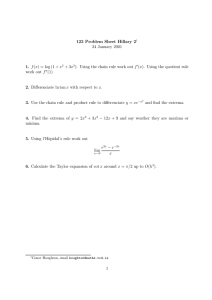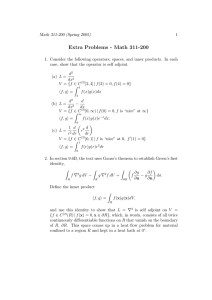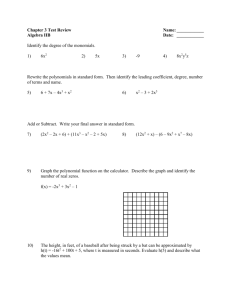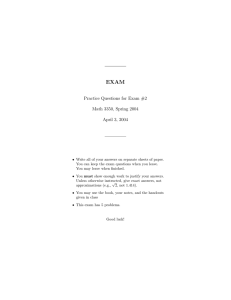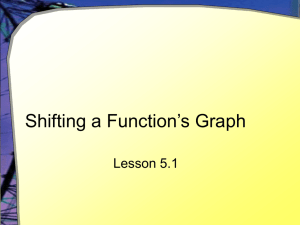Solns to 123 Problem Sheet Hillary 2 24 January 2001 + 3x
advertisement
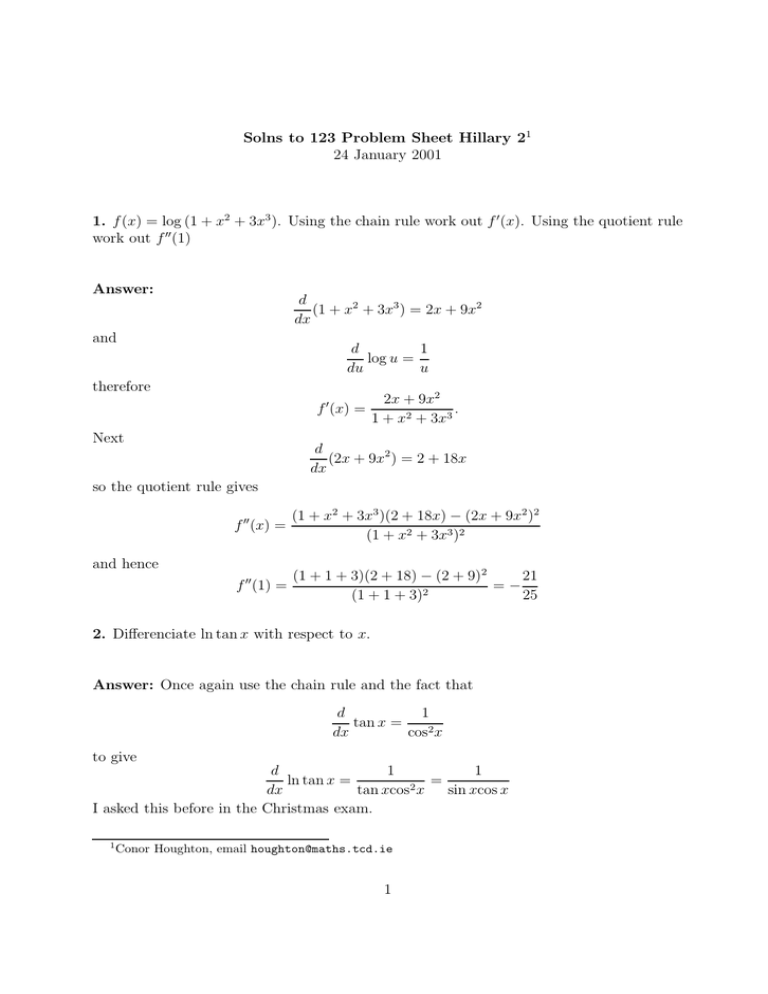
Solns to 123 Problem Sheet Hillary 21 24 January 2001 1. f (x) = log (1 + x2 + 3x3 ). Using the chain rule work out f 0 (x). Using the quotient rule work out f 00 (1) Answer: d (1 + x2 + 3x3 ) = 2x + 9x2 dx and d 1 log u = du u therefore f 0 (x) = Next 2x + 9x2 . 1 + x2 + 3x3 d (2x + 9x2 ) = 2 + 18x dx so the quotient rule gives f 00 (x) = and hence (1 + x2 + 3x3 )(2 + 18x) − (2x + 9x2 )2 (1 + x2 + 3x3 )2 (1 + 1 + 3)(2 + 18) − (2 + 9)2 21 f (1) = = − (1 + 1 + 3)2 25 00 2. Differenciate ln tan x with respect to x. Answer: Once again use the chain rule and the fact that d 1 tan x = dx cos2 x to give d 1 1 ln tan x = = 2 dx tan xcos x sin xcos x I asked this before in the Christmas exam. 1 Conor Houghton, email houghton@maths.tcd.ie 1 2 3. Use the chain rule and product rule to differenciate y = xe−x and find the extrema. Answer: d −x2 2 e = −2xe−x dx and so d −x2 2 2 xe = −2x2 e−x + e−x . dx √ This means the differencial has zeros when x = ±1/ 2 and these are the extrema. I have discussed this example before as well. The graph is below. 0.4 0.2 -3 -2 -1 1 x 2 3 -0.2 -0.4 4. Find the extrema of y = 2x3 + 3x2 − 12x + 9 and say weather they are maxima or minima. Answer: So dy = 6x2 + 6x − 12 = 6(x − 1)(x + 2) dx and hence the extrema are at x = 1 and x = −2. d2 y = 12x + 6 dx2 so d2 y = 18 > 0 dx2 x=1 2 and that point is a minimum. d2 y = −18 < 0 dx2 x=−2 and that point is a maximum. The graph is below. 50 40 30 20 10 -3 -2 -1 0 1 x 2 3 5. Using l’Hôpidal’s rule work out e2x − e−2x x→0 x lim Answer: Well the numerator and denominator are both zero for x = 0. This means we apply l’Hopidal’s rule: d 2x (e − e−2x ) = 2(e2x + e−2x ) dx and so e2x − e−2x = 2 lim (e2x + e−2x ) = 4 lim x→0 x→0 x 6. Calculate the Taylor expansion of cot x around x = π/2 up to O(h3 ). Answer: Again this is just an epic2 in differenciation: d 1 cot x = − 2 dx sin x 2 I won’t ask any Taylor series question this long in the exam 3 and d 1 d2 2 cos x cot x = − = 2 dx2 dx sin x sin3 x and finally d3 sin4 x + 3cos2 xsin2 d 2 cos x = −2 . cot x = dx3 dx sin3 x sin4 x Now sin π/2 = 1 and cos π/2 = 0 means that 1 cot (π/2 + h) = −h − h3 + O(h4 ) 3 4
